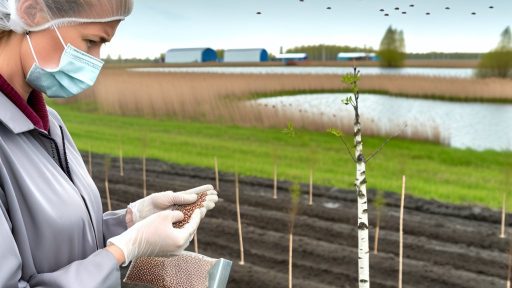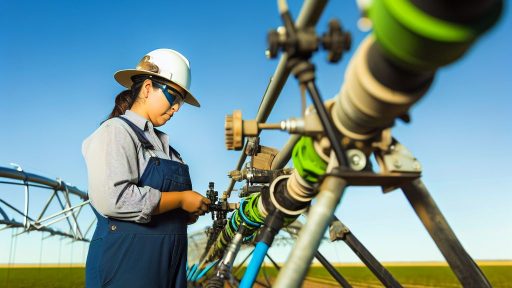Introduction to Tornadoes and Their Occurrence in the United States
Tornadoes are violent windstorms characterized by a rotating column of air.
They form during severe thunderstorms and can occur anywhere in the U.S.
The central part of the country, known as Tornado Alley, experiences the most tornadoes.
States like Texas, Oklahoma, and Kansas are frequently affected each year.
On average, the United States reports over a thousand tornadoes annually.
These natural disasters can cause devastating destruction to buildings and landscapes.
Additionally, tornadoes can dramatically impact agricultural lands.
Farmers often face significant challenges following tornado events.
In fact, tornadoes can lead to immediate financial losses for farms.
Determining the effects on farmland prices remains complex.
Various factors contribute to farmland value fluctuations after these storms.
Understanding the connection between tornadoes and farmland prices is essential.
This relationship can influence the broader agricultural economy.
As a result, analyzing data on tornado occurrences and farmland values is crucial.
Farmers, investors, and policymakers must pay close attention to these trends.
Transform Your Agribusiness
Unlock your farm's potential with expert advice tailored to your needs. Get actionable steps that drive real results.
Get StartedOverview of Farmland Values in Tornado-Prone Regions
Current State of Farmland Prices
Farmland prices vary widely across the United States.
In tornado-prone regions, these values often reflect environmental risks.
Farmers and investors consider the potential for tornado damage in their valuations.
Areas like Kansas and Oklahoma experience fluctuations in prices based on weather patterns.
Additionally, economic factors such as supply and demand play a crucial role.
Impact of Tornado Events
Tornadoes cause immediate destruction to farmland and structures.
This destruction can lead to significant financial loss for farmers.
Moreover, recovery costs often inflate farmland prices over time.
Investors may shy away from purchasing in high-risk areas.
Consequently, this fear can suppress overall market values in those regions.
Insurance Considerations
Insurance rates also reflect the risks associated with tornadoes.
Farmers often pay higher premiums for coverage against tornado damage.
These increased costs can deter potential buyers from investing in farmland.
Furthermore, inadequate insurance coverage may lead to financial ruin for some farmers.
Therefore, insurance plays a vital role in influencing farmland values.
Future Outlook for Farmland Prices
The future of farmland prices in tornado-prone areas remains uncertain.
Climate change could intensify tornado occurrences in certain regions.
This potential increase may deter investment, thus lowering farmland values.
On the other hand, technological advancements could mitigate some risks.
As a result, farmland values might stabilize or even increase over time.
Impact of Tornado Damage on Agricultural Productivity and Crop Yields
Agricultural Infrastructure Damage
Tornadoes severely damage agricultural infrastructure, impacting farming operations.
Damaged buildings and equipment hinder planting and harvesting schedules.
This disruption can lead to decreased crop yields and lower overall productivity.
Destruction of Crops
Tornadoes often destroy large swathes of crops in their path.
Showcase Your Farming Business
Publish your professional farming services profile on our blog for a one-time fee of $200 and reach a dedicated audience of farmers and agribusiness owners.
Publish Your ProfileHigh winds can uproot plants and strip leaves off, causing immediate loss.
As a result, farmers face significant financial losses and decreased market supply.
Long-Term Soil Health Effects
Soil quality can decrease due to tornadoes, impacting future crops.
Severe erosion can remove nutrient-rich topsoil essential for growth.
This degradation may take years to recover, limiting agricultural output.
Economic Ripple Effects
The economic impact of tornado damage extends beyond the farm level.
Local economies suffer as reduced agricultural productivity influences food supply.
Consequently, this situation can lead to increased prices and inflation in local markets.
Insurance and Recovery Challenges
Farmers face challenges when seeking insurance claims after tornadoes.
Disputes over coverage can delay necessary funding for recovery efforts.
These delays often vary, complicating the restoration of full farming operations.
Adaptation and Mitigation Strategies
Farmers can implement strategies to minimize tornado damage risk.
Investing in storm-resistant structures and smart crop management is crucial.
Additionally, local governments can promote community preparedness programs.
You Might Also Like: Creating Climate-Resilient Properties With Agroforestry Approaches
Insurance Implications for Farmers Post-Tornado Events
Assessing Damage and Losses
Farmers face immediate challenges after a tornado strikes their land.
They must quickly assess the extent of the damage to their crops and equipment.
This assessment helps in filing insurance claims in a timely manner.
Moreover, documenting losses thoroughly can significantly impact compensation amounts.
Navigating Insurance Policies
Many farmers rely on various insurance policies for coverage against natural disasters.
Common types of policies include crop insurance and property insurance.
It is crucial for farmers to review their policies often.
Understanding coverage limits and exclusions can prepare them for future events.
The Role of Insurance Agents
Local insurance agents play an essential role during the claims process.
They help farmers understand their options and navigate the paperwork.
Additionally, agents often assist in determining the right amount of coverage needed.
Claim Processing Challenges
Farmers may experience delays in claim processing after a tornado strike.
High volumes of claims can overwhelm insurance companies.
Also, disputes may arise regarding the assessment of damages.
Farmers should remain proactive and follow up regularly on their claims.
Long-term Financial Impacts
The aftermath of a tornado can have lasting financial implications for farmers.
Insurance payouts might not fully cover all losses faced.
This shortfall can lead to reduced investment in future crops and equipment.
Farmers may also struggle to secure loans during recovery periods.
Strategies for Post-Tornado Recovery
Implementing effective recovery strategies is vital for farmers.
First, they should create a detailed recovery plan with clear financial goals.
Secondly, diversifying crops can reduce risks associated with future storms.
Finally, investing in better preparedness tools can mitigate future damage.
See Related Content: How Water Rights Policies Influence Agricultural Land Prices
Market Response
Impact of Tornadoes on Farmland Prices
Tornadoes significantly impact farmland prices in affected areas.
Showcase Your Farming Business
Publish your professional farming services profile on our blog for a one-time fee of $200 and reach a dedicated audience of farmers and agribusiness owners.
Publish Your ProfileInitially, tornado damage creates a surge in repair costs for local farmers.
Consequently, this leads to a decrease in farmland prices shortly after such events.
Also, buyers often become wary due to perceived risks of severe weather.
As a result, the demand for farmland may decline temporarily.
Long-Term Price Adjustments
Over time, the real estate market adjusts to the new conditions.
Better building standards and recovery efforts can help stabilize prices.
Furthermore, as communities rebuild, interest in farmland may increase again.
This demand often raises prices back to pre-tornado levels or higher.
Investors often seek opportunities in revitalized areas.
Regional Variations in Market Response
Different regions respond uniquely to tornado impacts.
For instance, areas with stronger economies tend to recover faster.
In contrast, less economically stable regions may struggle longer.
Thus, the market response can vary based on local factors.
Ultimately, understanding these dynamics is crucial for potential buyers and sellers.
Monitoring Market Trends Post-Tornado
Tornadoes create immediate challenges for farmland valuation.
Subsequently, they also open up long-term recovery opportunities.
Stakeholders must carefully monitor market trends post-tornado.
Planning for future events can help mitigate risks and enhance recovery.
You Might Also Like: Smart Greenhouse Technologies for Climate-Resilient Farm Investments
Case Studies of Tornado Events and Their Effects on Local Farmland Prices
Tornado in Joplin, Missouri
The Joplin tornado struck in May 2011.
It was one of the deadliest tornadoes in U.S. history.
This event significantly affected local farmland prices.
Immediately after the tornado, farmland values dropped due to destruction.
Many farmers lost their crops and livestock during the disaster.
Consequently, the demand for farmland in the area decreased sharply.
Insurance payouts eventually helped some farmers recover.
However, it took years for land values to stabilize.
Today, farmland prices have grown but remain below pre-tornado levels.
Tornado in Moore, Oklahoma
The Moore tornado occurred in May 2013.
This tornado caused extensive damage to farmland.
As a result, local farmland prices initially plummeted.
Farmers faced difficulties in recovery due to soil erosion.
This issue hindered the productivity of affected lands.
Government assistance programs aided many farmers during this time.
Over time, some farmland values recovered as infrastructure improved.
Nevertheless, the area still faces challenges related to land quality.
Tornado Events in Alabama
In April 2011, a series of tornadoes swept through Alabama.
These tornadoes caused widespread devastation across rural communities.
Local farmland was severely impacted, leading to price fluctuations.
Many agricultural operations struggled to continue after this disaster.
Showcase Your Farming Business
Publish your professional farming services profile on our blog for a one-time fee of $200 and reach a dedicated audience of farmers and agribusiness owners.
Publish Your ProfileSome farmers chose to sell their damaged farmland at lower prices.
This action contributed to a temporary decrease in market values.
However, new investments and recovery efforts spurred growth over time.
Currently, many areas have seen rebounding prices due to revitalization efforts.
Factors Influencing Farmland Prices After Tornadoes
Several factors influence farmland prices post-tornado events.
- Extent of damage to crops and infrastructure affects market value.
- Local recovery initiatives can help stabilize prices.
- Insurance payouts play a crucial role in recovery for farmers.
- Soil health and agricultural productivity impact long-term land value.
Overall, the interplay of these factors shapes the future of farmland prices.
Find Out More: Managing Soil-Borne Diseases to Protect Agricultural Land Investments

Long-term Effects of Tornadoes on Agricultural Land Valuation and Investment
Impact on Land Valuation
Tornadoes can drastically alter the value of agricultural land.
After a tornado strikes, properties may suffer significant physical damage.
Such damage often decreases the land’s market value significantly.
Before investing, buyers carefully evaluate the extent of destruction.
Consequently, they may offer lower bids for affected farmland.
Insurance and Financial Implications
Tornadoes can lead to increased insurance premiums for farmers.
Insurance companies often categorize storm-prone areas as higher risk.
This reassessment can make coverage less affordable.
Farmers might face challenges securing loans due to greater financial instability.
As a result, they may have difficulty making necessary improvements.
Long-term Investment Trends
Investment trends often shift after tornado events.
Some investors may avoid regions frequently impacted by storms.
This avoidance can lead to decreased competition for agricultural properties.
Over time, however, others might see opportunities in rebuilding efforts.
This approach may lead to revitalization of affected areas.
Environmental Recovery
The land’s recovery after a tornado impacts its valuation.
Soil health and ecosystem stability can be compromised initially.
Nevertheless, with proper management, recovery is possible.
Farmers can implement strategies to restore and rejuvenate affected land.
Ultimately, the land’s condition plays a crucial role in its value over time.
Community and Economic Considerations
Tornadoes can disrupt local economies and communities.
As farmers struggle, the broader agricultural economy may also suffer.
Consequently, support initiatives may emerge to assist recovery.
Community rebuilding can foster resilience and long-term growth.
These efforts might eventually increase land values for invested stakeholders.
Mitigation Strategies and Policies for Tornado Resilience in Farming
Understanding Tornado Impacts
Tornadoes can severely damage farmland.
The destruction affects crops and livestock directly.
Furthermore, property damage leads to significant economic losses.
Consequently, farming prices fluctuate in tornado-prone areas.
Developing Resilient Farming Practices
Farmers can adopt resilience strategies to mitigate tornado effects.
One effective method is diversifying crop selection.
This strategy lowers the risk of total crop loss.
Additionally, implementing better soil management helps strengthen crops.
Showcase Your Farming Business
Publish your professional farming services profile on our blog for a one-time fee of $200 and reach a dedicated audience of farmers and agribusiness owners.
Publish Your ProfileThus, farmers can enhance their land’s resilience to extreme weather.
Infrastructure Improvements
Investing in robust farm infrastructure is vital.
Farmers should build tornado shelters for livestock and equipment.
Using resilient materials for barns and silos can reduce damage.
Thus, improved infrastructure minimizes losses during tornado events.
Utilizing Technology
Modern technology plays a key role in tornado preparedness.
Weather forecasting tools provide early alerts for tornadoes.
Additionally, precision agriculture technology enhances monitoring of crop health.
Consequently, farmers can make informed decisions during adverse weather.
Community Collaboration and Resources
Collaboration among farmers strengthens community resilience.
Local agricultural offices can provide educational resources on tornado preparedness.
Farmers should participate in workshops to learn about best practices.
This cooperation fosters a supportive network for sharing insights.
Government Policies and Support
Local and federal policies can support tornado mitigation efforts.
Effective policies include grants for building resilient infrastructure.
Additionally, crop insurance programs can protect farmers’ investments.
This assistance allows farmers to recover from tornado impacts more easily.
Emergency Response Plans
Developing emergency response plans is crucial for farmers.
These plans should include evacuation routes and communication strategies.
Farmers must regularly review and update their plans.
Effective planning reduces confusion during tornado warnings.
The Future of Farmland Pricing in the Context of Climate Change and Extreme Weather Patterns
Current Trends in Farmland Prices
Farmland prices have increasingly become volatile due to climate change.
Various environmental factors, including tornadic activity, affect land value.
These extreme weather events disrupt agricultural productivity and infrastructure.
As a result, farmers face higher risks which influence market prices.
Impact of Tornadoes on Farmland
Tornadoes cause immediate destruction to crops and buildings.
This damage results in significant financial losses for farmers.
Insurers may raise premiums or even withdraw coverage from high-risk areas.
Consequently, landowners may see their assets devalued post-tornado.
Long-Term Effects of Climate Change
Long-term weather patterns are shifting, increasing tornado frequency.
Farmers must adapt continuously to an unpredictable climate.
Investments in fortified structures can help mitigate damage.
However, higher costs may ultimately reduce farmland accessibility.
Strategies for Future Resilience
Adopting sustainable farming practices can bolster resilience.
Crop diversification minimizes risk posed by weather disturbances.
Incorporating advanced forecasting tools aids in better preparation.
Building community support networks can enhance recovery efforts.
Economic Implications
The ongoing volatility in weather patterns complicates investment decisions.
Investors may hesitate to commit to regions prone to tornadoes.
This hesitance can drive prices down in affected areas.
Showcase Your Farming Business
Publish your professional farming services profile on our blog for a one-time fee of $200 and reach a dedicated audience of farmers and agribusiness owners.
Publish Your ProfileConversely, regions with stable climates may see price increases.
Looking Ahead
The interplay of agriculture, climate change, and market dynamics will evolve.
Farmers and investors must remain vigilant and flexible.
Ultimately, adapting to new realities will dictate the conservation of farmland value.
Planning for extreme weather is now an essential consideration in agriculture.




